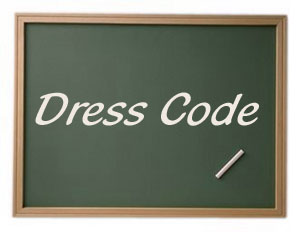 The implementation of student dress codes has increased over the past decade. The essence of the dress codes vary in reach. Some codes mandate specific uniforms, such as khaki or navy pants with a specific color polo or oxford shirt. Other codes ban specific items, such as flip-flops, midriffs, clothing with particular symbols, or clothing in particular colors. As school districts continue to improve educational outcomes, student dress codes will be a permanent fixture in many cities.
The implementation of student dress codes has increased over the past decade. The essence of the dress codes vary in reach. Some codes mandate specific uniforms, such as khaki or navy pants with a specific color polo or oxford shirt. Other codes ban specific items, such as flip-flops, midriffs, clothing with particular symbols, or clothing in particular colors. As school districts continue to improve educational outcomes, student dress codes will be a permanent fixture in many cities.
There are various reasons why districts implement dress codes. Commonly given rationales are to stop gang-related activity, increase focus on academics, reduce discipline referrals, and reduce stress associated with socioeconomic status. For example, if every student must wear the same attire, there will not be a focus on designer clothing and shoes. Thus, families in low-income areas will not have the stresses of trying to maintain expensive designer fashions.
Former President Bill Clinton posited a connection between student attire and student violence. In his 1996 State of the Union Address, Clinton
“challenge[fusion_builder_container hundred_percent=”yes” overflow=”visible”][fusion_builder_row][fusion_builder_column type=”1_1″ background_position=”left top” background_color=”” border_size=”” border_color=”” border_style=”solid” spacing=”yes” background_image=”” background_repeat=”no-repeat” padding=”” margin_top=”0px” margin_bottom=”0px” class=”” id=”” animation_type=”” animation_speed=”0.3″ animation_direction=”left” hide_on_mobile=”no” center_content=”no” min_height=”none”][d] all our schools to teach character education, to teach good values and good citizenship. And if it means that teenagers will stop killing each other over designer jackets, then our public schools should be able to require their students to wear school uniforms.”
He reasoned that school uniforms would lead to a decrease in student violence over name brand clothing.
Not all individuals believe in the propriety of student dress codes. There have been numerous federal suits that challenge the constitutionality of district imposed dress requirements. The constitutional objections tend to be in three main categories: (1) a violation of students’ First Amendment right to expression; (2) a violation of students’ First Amendment right to free expression; and (3) a violation of parents’ Fourteenth Amendment liberty right to raise their children in a manner of their choosing.
Although students cannot do whatever they want in the school setting, they do have some rights. In the 1968 landmark Supreme Court decision Tinker v. Des Moines Independent Community School District, the Court reasoned that students do not “shed their constitutional rights to freedom of speech or expression at the schoolhouse gate.” Some petitioners of the school dress code cases use the reasoning of Tinker to argue that dress codes violate the First Amendment rights of students.
In Canady v. Bossier Parish School Board (2001), the Fifth Circuit Court of Appeals ruled that a school district’s dress code did not violate a student’s First Amendment rights. The state law at issue in Canady gave local school boards the option to implement dress codes. The local boards were required to give parents written notice of the decision to implement dress codes as well as a rationale. Parents eventually sought an injunction (a legal order requiring someone to do or refrain from doing something) against enforcement of the code. The parents alleged a violation of free expression, religious preferences, and the liberty right to rear children.
Bossier Parish School Board submitted affidavits showing that the dress code caused a reduction in discipline referrals and an increase in test scores. The court explained that the purpose of the code was unrelated to the suppression of student speech and was geared towards increasing educational processes. Thus, the dress code was upheld.
School districts do not always win in dress code cases. In Barber v. Dearborn Public Schools (2003), a high school student wore a shirt with a photograph of former President George W. Bush. Written underneath the photo were the words “International Terrorist.” The court in Barber granted the student’s injunction against the school district, reasoning that the student was disciplined mainly because of disagreement with the message on the shirt.
In ruling on student dress codes, courts seem to examine the rationale behind implementing and applying the policy. Policies that increase educational processes tend to be upheld. The Supreme Court has yet to directly address this issue.
Now how do you feel about student dress codes?[/fusion_builder_column][/fusion_builder_row][/fusion_builder_container]





i think the schools should tighten down on the dress code. too many girls walk around with belly shirts with shorts that are no longer than my underwear, which aren’t long, and its ridiculous!
Honestly i don’t see how anyone would kill someone for what they wear, it is just stupid. Also Clothing is not a distraction in school, i can’t tell you how many teachers i have that yell at us for having a hat on.
That being said i prefer schools with Dress Codes. It creates a uniformity that grants the school a measure of dignity and formality that makes the school’s image look better.
Once again that being said I go to a school that doesn’t have much of a dress code. (Occasionally you even see a guy wearing a dress… weird but not forbidden.) I’ll admit i enjoy being comfortable in the clothes i choose to wear, I know that this is a a problem more geared towards girls. Being a guy it doesn’t effect me all that much. Anyway my two cents into this matter. Peace out.
My daughter, a very good student, NEVER has gotten into trouble since K and is now a Freshman, just got Dress code….for small holes AT the knee, no fraying…..Girls wear shorts above the knee there, but she can’t wear jeans with holes at the knee only? I don’t understand. It wasn’t in poor taste, she has good taste in clothing actually. I just want to know, does this seem right. I had to bring her home to change, which kept her away from her education because they are so worried about punishing. I don’t get it. I need some opinions on this, please. This school is getting out of hand. No where in the handbook does it say anything about jeans with hole, AT ALL…but they told me it was a health hazard? Can someone explain why this is a health hazard?
I’m an art student at LNHS and I gotta say that style is my thing and I like to express myself not through trends but through unique clothing styles that expresses how I feel for the day. The dress code here is very strict and I got dress coded once for wearing shorts when it was 95 degree weather wich I thought was pretty ridiculous since I just came from up North. Last year, I came from a different school in a different county that did not hardly have a dress code and a lot more freedom. I was not depressed and failing my grades as badly as I am this year because I had my freedom and it kept me positive about society today but now that I came to this school, I feel like I am in a jail cell restricted to wear what I want to wear and eat wear I want to eat. Last year when I was at my other school I got to eat anywhere throughout the school and it really gave me a peace of mind because I was not forced to sit only around the cafeteria where it is so noisy and crowded with over 500 people. I really don’t see how these restrictions are a distraction for people with education because for me, seeing nature and experiencing many different personalities that come from people is my education. But now, all I see is just black or white. I also don’t like this in terms for when it comes to freedom of expression in the first amendment. I focus when I see uniqueness not “robotics” that are just trying to improve what they think of as a “real school image”. .